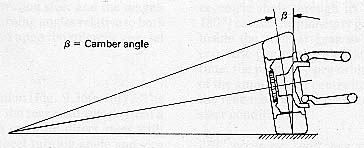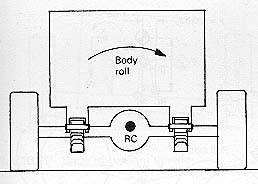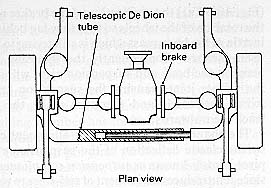Basic Concept
Ride
Basically, suspensions are employed to deal with humps in the road surface, in other words, enhancing ride comfort. When a car rides over a hump, the springs are compressed, store the energy thus provide shock absorption. The energy will be released quickly when the springs bounce back. Dampers are employed to smooth and slow down the bounce motion, this is called "Damping". Without dampers, the car will bounce up and down severely and quickly, this is perceived as uncomfortable. Study found that ride is perceived as comfortable by human when the bouncing frequency is 1 to 1.5 Hz. If it exceeds 2 Hz, most people feel the ride harsh. Therefore ride quality is mostly controlled by the selection of suitable springs and dampers.
Handling
In order to achieve ride comfort, we create suspensions that let the wheels move with respect to the car body. Inevitably, this creates many many problems in handling. When the car is turning quickly into a bend, centrifugal force will roll the car body. Body roll leads to the weight transfer towards the outside wheels, it also changes the suspensions geometry which changes the camber angles of wheels. Change of camber accompanies with weight transfer result in unwanted understeer or oversteer. If brakes are applied in the bend, castor angles will also be changed, that may further deteriorated understeer/ oversteer or even introduces torque steer. (Don't understand ? No problem, you will have a clearer view in the following paragraphs)
Camber
This is a very important concept we must learn before going on
As shown in below, if a wheel is not perpendicular to the road, then it is cambered. If it leans towards the center of the car, then it is negative cambered. If it leans outwards to the car, it is positive cambered (as shown in the following picture.)

When a wheel has positive camber, due to the elasticity of tires, the wheel will be reshaped to something like the base of a cone. It will have a tendency to rotate about the peak of the cone, as shown in the picture. Now, you will see the wheel tries to steer away from the center of the car.
If both the right and left wheels are positive cambered (that means they lean towards opposite directions), the steering tendency will be cancelled so that the car remains running in straight line. If the car is turning into a corner, body roll puts more weight on the outside wheels than the inside wheels, that means the outside wheel's steering tendency will have more influence to the car. As the positive-cambered outside wheel tries to steer the car to the outside of the corner, the car will understeer.
On the contrary, if both wheels are negative cambered, the car will oversteer.
A Good Suspension must :
1) Provide independent shock absorption to individual wheels. That means, when one wheel rides over a hump, the shock will not be transferred to other wheels.
2) Has adequate body roll. Excessive body roll leads to too much weight transfer thus influence the steering response. It is not comfortable too. Restrict body roll to minimal may create uncomfortable feeling because of excessive g-force. Moreover, body roll could provide information to the driver, telling him the state of cornering and whether the car has reached its limit. Completely eliminate body roll is not at all good.
3) Has a good geometry such that wheel cambers remain unchanged in all conditions, that is, acceleration, braking, cornering, load and bumps.
Body roll suppression usually conflict with ride comfort, because the former requires stiffer spring and dampers while the latter vice versa. Nevertheless, clever suspension geometry may improve body roll without altering the ride. Here in below we are going to discuss the most popular kinds of suspension geometry.
Non-independent suspension
Live / Dead axle

Until the late 70s, most cars still used this simple non-independent suspensions, especially at the rear axle. Basically, it is a rigid axle fixed between left and right wheels. The car body is suspended by leaf springs or coil springs on the axle / wheels unit.
As you can see, the wheels are not independent. When one wheel rides on a hump, the shock will be transferred to another wheel. Besides, both wheels will be cambered, thus non-neutral steering is inevitable.
If the axle is also the driving axle, it is called Live Axle. Live axle is very heavy. It consists of the final drive / differential, drive shafts and a strong tube enclosing all these things. Since the whole axle is rigidly fixed to the wheels instead of suspended by springs, the so-called Unsprung Weight is very high.
What is the result of high unsprung weight ? Assuming a live axle meets a hump and "jump" quickly upward, the more weight it has, the more momentum it gains (because momentum = the product of mass and velocity). That means the more momentum the springs have to deal with. Of course, springs cannot absorb all the momentum, so eventually part of the latter will be transferred to the car body in the form of shock. Therefore live axle is never good at ride quality.
If the axle is not the driving axle, it is called Dead Axle. Without the driving mechanism incorporated, dead axle has much less unsprung weight, so its ride quality is better than Live Axle. Anyway, comparing them is useless - it does not make sense for a car to use dead axle in the non-drive wheels while using a suspension advancer than live axle in the driving wheels. Independent MacPherson suspension is rather easy and cost-effectively to replace the non-drive dead axle. If a car maker cannot afford such little additional cost, it must not willing to employ advancer suspensions in the driving wheels also.
Live / Dead Axle have another disadvantage - body roll is not sufficiently suppressed. Springs are the only element which control the body roll, however, stiffen the springs will inevitably deteriorate ride quality. Moreover, if coil springs are used, lateral force due to cornering will lead to transverse movement of the car body, thus result in weight transfer and affect steering response.
The popular solution was to add some control arms between the car body and the axle, such as Panhard rod and Watt link. However, they are out of our scope.
Advantage: Cheap. Body roll does not influence the camber of wheels.
Disadvantage: Non-independent, bad ride quality, both wheels cambered on bump.
Who use it ? Some American sedans, Ford Mustang, Falcon, most SUV.
DeDion Axle

Although independent suspensions were invented decades ago, non-independent suspensions still dominated the market until the late 70s. The first reason was: cheap. The second reason: it offers quite good handling despite of poor ride. Since the wheels are rigidly linked by an axle, they remain perpendicular to the road surface regardless of body roll. Therefore the car corners quite stable. In contrast, in many types of independent suspensions, camber angle may be changed due to body roll.
However, as explained before, live axle has too much unsprung weight, thus leads to poor ride quality. Therefore many budget sports cars or coupes chose DeDion Axle (rear) suspensions over live axle.
DeDion axle suspension has much less unsprung weight because the final drive / differential and driving shafts are not rigidly attached to the wheels. Like independent suspensions, they are part of the car body and flexibly linked to the wheels by universal joints. In other words, they are sprung.
The wheels are interconnected by a DeDion Tube, which has a sliding joint to permit wheel track variation during suspension movement, this help refining ride quality too. The DeDion tube keeps both wheels parellel to each other under all conditions, so they are always perpendicular to the road surface regardless of body roll.
Advantage: Still cheaper than most independent suspensions. Body roll does not influence the camber of wheels. Better ride quality than Live Axle.
Disadvantage: Non-independent, ride is still worse than independent suspensions. Both wheels cambered on bump.
Who use it ? Caterham, Vector, Smart.
Ride
Basically, suspensions are employed to deal with humps in the road surface, in other words, enhancing ride comfort. When a car rides over a hump, the springs are compressed, store the energy thus provide shock absorption. The energy will be released quickly when the springs bounce back. Dampers are employed to smooth and slow down the bounce motion, this is called "Damping". Without dampers, the car will bounce up and down severely and quickly, this is perceived as uncomfortable. Study found that ride is perceived as comfortable by human when the bouncing frequency is 1 to 1.5 Hz. If it exceeds 2 Hz, most people feel the ride harsh. Therefore ride quality is mostly controlled by the selection of suitable springs and dampers.
Handling
In order to achieve ride comfort, we create suspensions that let the wheels move with respect to the car body. Inevitably, this creates many many problems in handling. When the car is turning quickly into a bend, centrifugal force will roll the car body. Body roll leads to the weight transfer towards the outside wheels, it also changes the suspensions geometry which changes the camber angles of wheels. Change of camber accompanies with weight transfer result in unwanted understeer or oversteer. If brakes are applied in the bend, castor angles will also be changed, that may further deteriorated understeer/ oversteer or even introduces torque steer. (Don't understand ? No problem, you will have a clearer view in the following paragraphs)
Camber
This is a very important concept we must learn before going on
As shown in below, if a wheel is not perpendicular to the road, then it is cambered. If it leans towards the center of the car, then it is negative cambered. If it leans outwards to the car, it is positive cambered (as shown in the following picture.)

When a wheel has positive camber, due to the elasticity of tires, the wheel will be reshaped to something like the base of a cone. It will have a tendency to rotate about the peak of the cone, as shown in the picture. Now, you will see the wheel tries to steer away from the center of the car.
If both the right and left wheels are positive cambered (that means they lean towards opposite directions), the steering tendency will be cancelled so that the car remains running in straight line. If the car is turning into a corner, body roll puts more weight on the outside wheels than the inside wheels, that means the outside wheel's steering tendency will have more influence to the car. As the positive-cambered outside wheel tries to steer the car to the outside of the corner, the car will understeer.
On the contrary, if both wheels are negative cambered, the car will oversteer.
A Good Suspension must :
1) Provide independent shock absorption to individual wheels. That means, when one wheel rides over a hump, the shock will not be transferred to other wheels.
2) Has adequate body roll. Excessive body roll leads to too much weight transfer thus influence the steering response. It is not comfortable too. Restrict body roll to minimal may create uncomfortable feeling because of excessive g-force. Moreover, body roll could provide information to the driver, telling him the state of cornering and whether the car has reached its limit. Completely eliminate body roll is not at all good.
3) Has a good geometry such that wheel cambers remain unchanged in all conditions, that is, acceleration, braking, cornering, load and bumps.
Body roll suppression usually conflict with ride comfort, because the former requires stiffer spring and dampers while the latter vice versa. Nevertheless, clever suspension geometry may improve body roll without altering the ride. Here in below we are going to discuss the most popular kinds of suspension geometry.
Non-independent suspension
Live / Dead axle

Until the late 70s, most cars still used this simple non-independent suspensions, especially at the rear axle. Basically, it is a rigid axle fixed between left and right wheels. The car body is suspended by leaf springs or coil springs on the axle / wheels unit.
As you can see, the wheels are not independent. When one wheel rides on a hump, the shock will be transferred to another wheel. Besides, both wheels will be cambered, thus non-neutral steering is inevitable.
If the axle is also the driving axle, it is called Live Axle. Live axle is very heavy. It consists of the final drive / differential, drive shafts and a strong tube enclosing all these things. Since the whole axle is rigidly fixed to the wheels instead of suspended by springs, the so-called Unsprung Weight is very high.
What is the result of high unsprung weight ? Assuming a live axle meets a hump and "jump" quickly upward, the more weight it has, the more momentum it gains (because momentum = the product of mass and velocity). That means the more momentum the springs have to deal with. Of course, springs cannot absorb all the momentum, so eventually part of the latter will be transferred to the car body in the form of shock. Therefore live axle is never good at ride quality.
If the axle is not the driving axle, it is called Dead Axle. Without the driving mechanism incorporated, dead axle has much less unsprung weight, so its ride quality is better than Live Axle. Anyway, comparing them is useless - it does not make sense for a car to use dead axle in the non-drive wheels while using a suspension advancer than live axle in the driving wheels. Independent MacPherson suspension is rather easy and cost-effectively to replace the non-drive dead axle. If a car maker cannot afford such little additional cost, it must not willing to employ advancer suspensions in the driving wheels also.
Live / Dead Axle have another disadvantage - body roll is not sufficiently suppressed. Springs are the only element which control the body roll, however, stiffen the springs will inevitably deteriorate ride quality. Moreover, if coil springs are used, lateral force due to cornering will lead to transverse movement of the car body, thus result in weight transfer and affect steering response.
The popular solution was to add some control arms between the car body and the axle, such as Panhard rod and Watt link. However, they are out of our scope.
Advantage: Cheap. Body roll does not influence the camber of wheels.
Disadvantage: Non-independent, bad ride quality, both wheels cambered on bump.
Who use it ? Some American sedans, Ford Mustang, Falcon, most SUV.
DeDion Axle

Although independent suspensions were invented decades ago, non-independent suspensions still dominated the market until the late 70s. The first reason was: cheap. The second reason: it offers quite good handling despite of poor ride. Since the wheels are rigidly linked by an axle, they remain perpendicular to the road surface regardless of body roll. Therefore the car corners quite stable. In contrast, in many types of independent suspensions, camber angle may be changed due to body roll.
However, as explained before, live axle has too much unsprung weight, thus leads to poor ride quality. Therefore many budget sports cars or coupes chose DeDion Axle (rear) suspensions over live axle.
DeDion axle suspension has much less unsprung weight because the final drive / differential and driving shafts are not rigidly attached to the wheels. Like independent suspensions, they are part of the car body and flexibly linked to the wheels by universal joints. In other words, they are sprung.
The wheels are interconnected by a DeDion Tube, which has a sliding joint to permit wheel track variation during suspension movement, this help refining ride quality too. The DeDion tube keeps both wheels parellel to each other under all conditions, so they are always perpendicular to the road surface regardless of body roll.
Advantage: Still cheaper than most independent suspensions. Body roll does not influence the camber of wheels. Better ride quality than Live Axle.
Disadvantage: Non-independent, ride is still worse than independent suspensions. Both wheels cambered on bump.
Who use it ? Caterham, Vector, Smart.




Comment